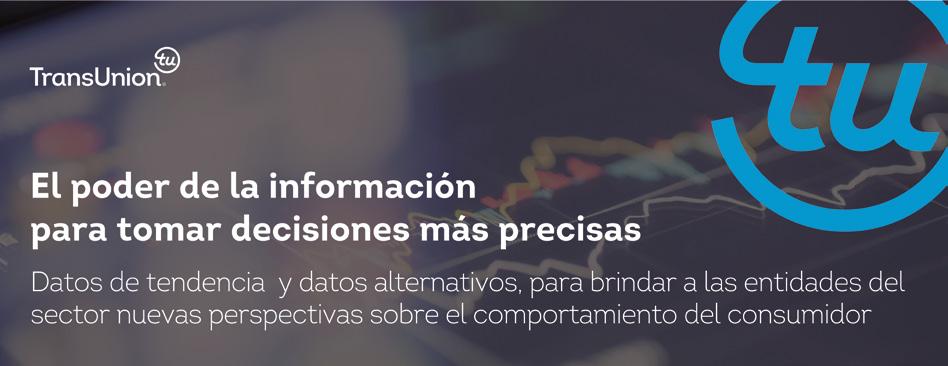
13 minute read
TRANSUNION
FINTECHS IN TRANSUNION
At TransUnion we have ten years of experience working with the FinTech industry around the world. In the United States and the United Kingdom, we were partners with FinTechs since their inception, when the FinTech world was still considered a novelty. We are participants and witnesses to the transformative effect that FinTechs have had on the financial services industry in these developed markets and how they established themselves as relevant competitors in their sectors.
Advertisement
From the United States and the United Kingdom, TransUnion’s efforts with the FinTech industry have expanded around the world. Today FinTechs have dedicated resources at TransUnion whose objective is to identify, shape and satisfy the particular needs of FinTechs in terms of data, analysis, innovation, speed, solutions and technology. Today we have exclusive teams to work with FinTechs in ten countries: United States, United Kingdom, Colombia, Canada, Brazil, India, Hong Kong, Philippines, South Africa and Kenya.
Although in recent years most FinTechs have defined growth as their main objective, today there is a greater interest in the profitability of this industry. The acquisition of clients as an expansion mechanism continues to be key within the life cycle of FinTechs; however, the focus on profitability has become decisive to guarantee its sustainability. Today, more selective capital investments are made in order to –in addition to growth– generate profitability.
MYTHS AND REALITIES: POPULAR BELIEFS ABOUT FINTECHS

At TransUnion we developed a study to evaluate various hypotheses about FinTechs. For example, it tends to be assumed that FinTechs primarily attract younger consumers, that they cater to unbanked consumers, and that they are tech companies with unsophisticated credit strategies.
In the United States, the TransUnion data shows that all these hypotheses are false: FinTechs that grant credit in the United States provide services to a large number of consumers of different ages who have a high level of access to credit, similar to the clients of the traditional banks. In addition, they employ more robust credit risk strategies compared to the traditional credit market, since they take into account more variables and alternative data to make their decisions and personalize their offers (for example, designing price structures and differential rates based on the risk). When analyzing the data in a less developed market like India we find that some of the hypotheses are beginning to come true. In India the FinTech consumer tends to be younger and less experienced in the credit market than the traditional bank consumer. However, FinTechs in India are not unsophisticated: they have very effectively entered the segment of short-term loans and smaller amounts and have surpassed other entities in terms of market share in just two years.
How is the FinTech market in Colombia? As in India, FinTechs in Colombia serve young consumers and offer short-term loans. However, they are aimed at consumers with experience in the credit market: at the time of accessing a FinTech loan, 57% of consumers already had a payroll loan and 64% a credit card.
On the other hand, our data shows a similarity between the FinTech and Retail sectors (industry and trade sector) in terms of consumer and credit profiles. Both FinTech and Retail entities (Industry and Trade) grant loans of COP 1 million on average, with a term of less than 12 months and to consumers under 35 years of age.
Information can help develop industry, facilitate business and improve people’s living standards

¿Cómo es el mercado FinTech en Colombia? ¿Cómo es el mercado FinTech en Colombia?
Al igual que en India, las FinTechs en Colombia atienden a consumidores jóvenes y ofrecen créditos a corto plazo. Sin embargo, se dirigen a consumidores con experiencia en el mercado de crédito: al momento de acceder a un crédito FinTech, el 57% de los consumidores ya tenía un crédito de libranza y el 64% una tarjeta de crédito. Al igual que en India, las FinTechs en Colombia atienden a consumidores jóvenes y ofrecen créditos a corto plazo. Sin embargo, se dirigen a consumidores con experiencia en el mercado de crédito: al momento de acceder a un crédito FinTech, el 57% de los consumidores ya tenía un crédito de libranza y el 64% una tarjeta de crédito. Por otro lado, nuestros datos muestran una similitud entre los sectores FinTech e Industria y Comercio en términos de perfiles de consumidores y créditos. Tanto las entidades FinTech como Retail otorgan créditos de $1 millón de pesos en promedio, con un plazo menor a 12 meses y a consumidores menores de 35 años.Por otro lado, nuestros datos muestran una similitud entre los sectores FinTech e Industria y Comercio en términos de perfiles de consumidores y créditos. Tanto las entidades FinTech como Retail otorgan créditos de $1 millón de pesos en promedio, con un plazo menor a 12 meses y a consumidores menores de 35 años.

Promedio de desembolso (Originaciones 1er Semestre 2019)
14.504 Promedio de desembolso (Originaciones¿Cómo es el mercado FinTech en Colombia? 1er Semestre 2019) TransUnion’s credit assessment tools aimed at 11.880 14.504 Al igual que en India, las FinTechs en Colombia atienden a consumidores jóvenes y ofrecen créditos a corto ¿Cómo es el mercado FinTech en Colombia? the FinTech ecosystem are based on trend data FinTech Bancos Otras entidades Industria y Comercio 11.880 FinTech Bancos Otras entidades plazo. Sin embargo, se dirigen a consumidores con experiencia en el mercado de crédito: al momento de acceder a un crédito FinTech, el 57% de los consumidores ya tenía un crédito de libranza y el 64% una tarjeta de crédito. Al igual que en India, las FinTechs en Colombia atienden a consumidores jóvenes y ofrecen créditos a corto plazo. Sin embargo, se dirigen a consumidores con experiencia en el mercado de crédito: al momento de acceder a un crédito FinTech, el 57% de los consumidores ya tenía un crédito de libranza y el 64% una tarjeta de crédito. and alternative data, offering new perspectives on consumer behavior. 4.248 CooperativasIndustria y ComercioPor otro lado, nuestros datos muestran una similitud entre los sectores FinTech e Industria y Comercio en 1.044 1.139 1.044 1.139 4.248 Cooperativas términos de perfiles de consumidores y créditos. Tanto las entidades FinTech como Retail otorgan créditos de $1 millón de pesos en promedio, con un plazo menor a 12 meses y a consumidores menores de 35 años.Por otro lado, nuestros datos muestran una similitud entre los sectores FinTech e Industria y Comercio en términos de perfiles de consumidores y créditos. Tanto las entidades FinTech como Retail otorgan créditos de $1 millón de pesos en promedio, con un plazo menor a 12 meses y a consumidores menores de 35 años. Every day it is possible to screen more consumers
*Valores expresados en millones de pesos colombianos *Valores expresados en millones de pesos colombianos Promedio de desembolso (Originaciones 1er Semestre 2019) who do not have a traditional credit history and Sin embargo, las FinTechs asumen más riesgo crediticio en comparación con otros sectores (incluyendo el sector de industria y comercio). Los datos de la industria del primer semestre de 2019 evidenciaron que la mitad de los créditos de libre inversión emitidos por FinTechs se otorgaron a perfiles de alto riesgo, mientras que la mayoría de los créditos tipo Retail se otorgaron a consumidores de riesgo medio. Por otro lado, las cooperativas de crédito, los bancos y otras instituciones financieras se concentraron en consumidores de bajo riesgo. Sin embargo, las FinTechs asumen más riesgo crediticio en comparación con otros sectores (incluyendo el sector de industria y comercio). Los datos de la industria del primer semestre de 2019 evidenciaron que la mitad de los créditos de libre inversión emitidos por FinTechs se otorgaron a perfiles de alto riesgo, mientras que la mayoría de los créditos tipo Retail se otorgaron a consumidores de riesgo medio. Por otro lado, las cooperativas de However, FinTechs take on more credit risk 14.504 11.880 Promedio de desembolso (Originaciones 1er Semestre 2019) 14.504 identify the least risky among populations that were previously considered high risk. Through 0% 25% 50% 75% 100% Riesgo alto Riesgo medio - alto Riesgo medio Riesgo bajo% acumulado de originaciones Bancos Otras entidades Cooperativas FinTechs I&C Coop Otras entidades Bancos Distribución por riesgo (primer semestre de 2019) Industria & Comercio FinTechs 0% 25% 50% 75% 100% Riesgo alto Riesgo medio - alto Riesgo medio Riesgo bajo% acumulado de originaciones Bancos Otras entidades Cooperativas FinTechs I&C Coop Otras entidades Bancos Distribución por riesgo (primer semestre de 2019) IndustriaFinTechs crédito, los bancos y otras instituciones financieras se concentraron en consumidores de bajo riesgo. compared to other sectors (including the Retail sector). Industry data for the first half of 2019 showed that half of the free investment credits issued by FinTechs were granted to high-risk profiles, while the majority of Retailtype credits were granted to medium-risk consumers. On the other hand, credit unions, banks, and 1.044 1.139 4.248 FinTech Bancos Otras entidades *Valores expresados en millones de pesos colombianos Sin embargo, las FinTechs asumen más riesgo crediticio en comparación con otros sectores (incluyendo el sector Industria y Comercio Cooperativas 1.044 11.880 1.139 4.248 FinTech Bancos Otras entidades *Valores expresados en millones de pesos colombianos Industria y Comercio Cooperativas TransUnion tools, FinTechs can contribute to expanding access to credit by controlling risk and contributing to the development of a more dynamic and formal economy. In a growth strategy, access channels are a fundamental pillar. In recent years, the expansion & Comercio other financial institutions focused on low-risk consumers. de industria y comercio). Los datos de la industria del primer semestre de 2019 evidenciaron que la mitad de los créditos de libre inversión emitidos por FinTechs se otorgaron a perfiles de alto riesgo, mientras que la mayoría de los créditos tipo Retail se otorgaron a consumidores de riesgo medio. Por otro lado, las cooperativas de crédito, los bancos y otras instituciones financieras se concentraron en consumidores de bajo riesgo. Sin embargo, las FinTechs asumen más riesgo crediticio en comparación con otros sectores (incluyendo el sector de industria y comercio). Los datos de la industria del primer semestre de 2019 evidenciaron que la mitad de los créditos de libre inversión emitidos por FinTechs se otorgaron a perfiles de alto riesgo, mientras que la mayoría de los créditos tipo Retail se otorgaron a consumidores de riesgo medio. Por otro lado, las cooperativas de of digital channels has allowed entities such as FinTechs to reach more consumers, becoming Distribución por riesgo (primer semestre de 2019) crédito, los bancos y otras instituciones financieras se concentraron en consumidores de bajo riesgo. attractive to the youngest, the still unbanked, and
100% % acumulado de originaciones 0% 25% 50% 75% Distribución por riesgo (primer semestre de 2019)
100% Riesgo alto Riesgo medio - alto Riesgo medio Riesgo bajo Bancos Otras entidades Cooperativas FinTechs I&C Coop Otras entidades Bancos IndustriaFinTechs 0% 25% 50% 75% Riesgo alto Riesgo medio - alto Riesgo medio Riesgo bajo% acumulado de originaciones FinTechs I&C Coop Otras entidades Bancos FinTechs Bancos & ComercioOtras entidades Industria Cooperativas & Comercio
FinTechs as an engine of financial inclusion in the country In Colombia, FinTechs contribute to the financial inclusion strategy with a multidimensional approach to assessing consumer risk. By leveraging the use of tools and technology, they can expand their universe of consumers and thus reach segments traditionally underserved by the traditional financial sector.
facilitating access in geographic areas without physical coverage from traditional financial entities. The challenge today for FinTechs is to continue expanding their presence in the digital world with greater security.
Remote Channel Origination: Keeping fraud under control without sacrificing customer experience
From the point of view of risk management and in the context of digitization, the great challenge for FinTechs today is to face the threats of
impersonation and transactional fraud. Today the entities that provide services through digital channels must offer a strategy that is robust to combat fraud and at the same time
friendly, simple and secure for their clients. The challenge of balancing risk and benefit is great and fortunately there are ways to overcome it.
Leveraging on anti-fraud intelligence based on information from the electronic device (mobile phones, tablets, computers, and any other device connected to the internet) is important as it becomes the preferred platform for consumers (and also for fraudsters) .
According to data from iovation®, a TransUnion company, last year 51% of the online transactions of financial services entities were carried out through mobile devices (compared to 49% through desktop computers).
At the same time, the suspicion of fraud via mobile devices in the financial sector has increased: the percentage of transactions declined due to possible fraudulent behavior within the financial sector customer segment doubled, jumping from 21% (2017) to 41% (2018).
Fraudsters frequently build their identities and credit profiles using specific devices. Therefore, identifying fraudsters through their mobile devices is essential to prevent the proliferation of fraudulent identities and associated losses.
So, what can FinTechs looking to expand their presence in the digital world do? Essential is ensuring that their fraud prevention processes and technology are aligned with their strategy. This usually implies adopting modular, integrated and scalable solutions that provide different levels of security adjusted to the risk being evaluated, without affecting the customer experience.
In terms of authentication, there are tools for the validation of identity documents and facial recognition, which allow contrasting images that the person can capture with their cell phone and analyze them, associating them with the risk of fraud associated with the device to reduce the risk.
From our experience in developing information solutions to fight fraud, we know that something fundamental is to link the traditional validation of people’s identity with the validation of what we now call “digital identity”.
New to Credit consumers, a segment to explore
New to Credit consumers are defined as those who obtain their first credit risk score. These present a challenge for lenders due to the lack of traditional credit information in their credit histories. They are often perceived as riskier, and their credit needs may not be properly understood.
In the first study carried out by TransUnion in Colombia on New to Credit consumers, it is observed that since 2015, more than 1.5 million people annually enter the Colombian credit market and obtain their first credit risk score (around 5% of the country’s total adult population).
Credit institutions seeking organic growth should pay attention to New to Credit consumers
This study shows that only 2% of New to Credit consumers had a first credit score in the higher risk range (“subprime”) compared to 19% of the established credit population. The vast majority (82%) of New to Credit consumers were in the medium-high risk category (“near prime”), a range above subprime, in the month in which they acquired their first score.
In addition, many of those consumers who started their formal credit history with a near prime risk score advanced to a lower risk range (better score) in the next 12 months: although New to Credit consumers had more volatile scores and therefore more likely to see their initial scores change over a 12-month period versus established credit consumers, the study showed that a significant percentage of the changes in New to Credit scores were positive rather than negative.
These and other findings from the study show the ability of many New to Credit consumers to improve their initial credit scores relatively quickly by managing the first credit accounts
well and making timely payments. The stability or improvement of the risk score of the vast majority of New to Credit consumers provides confidence to the FinTech ecosystem to enter this segment.

For these consumers who are just beginning their credit life, as well as for those who do not yet have a score, TransUnion has developed solutions that allow to qualify up to five million additional consumers who today do not have a traditional credit history and complement internally developed models by some FinTechs.
At TransUnion we are participants in the advances led by FinTechs and we work hand in hand with the sector to move rapidly towards greater financial inclusion in Colombia.
We are engaged in building responsible relationships, honest and trustworthy with each of our clients











